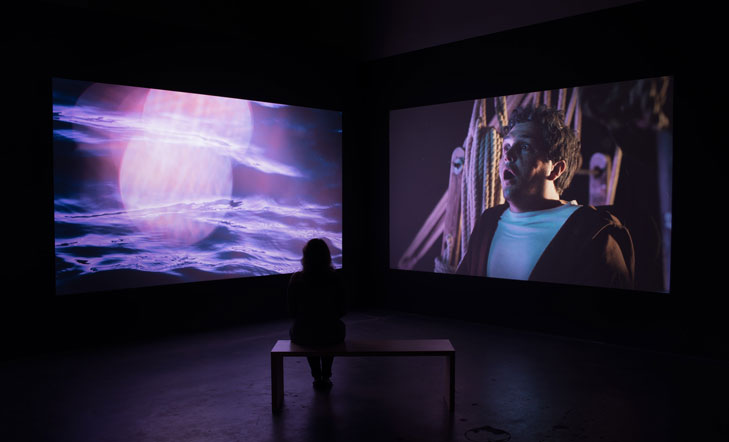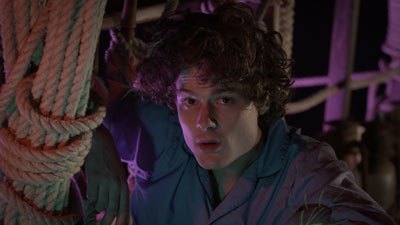Christopher Richmond’s “Double Fantasy,” a pairing of his videos Panthalassa (2015) and Rendezvous (2016) in his solo debut at Moskowitz Bayse, like much video work, challenges the audience, understandably not wanting to be easy or mere “entertainment.” Brimming with filmic and literary references and lush visuals, Richmond’s work occupies the space of cinema more than video art, and Richmond deftly employs and gleefully subverts conventional narrative strategies. At times it feels self-indulgent—one must be willing to delve into the fragmented story-lines layered with folktales, arcane factoids inserted like extraneous shopping lists in David Byrne-meets-David Foster Wallace moments, and science fiction. His point is not to make sense; rather, he synthesizes and encodes in a polymathic manner, delivering an experience analogous to an altered state in which sense dissolves. Yet the work is charming, even seductive.
Panthalassa, a 49-minute, two-channel HD video, takes its name from the ocean that surrounded the supercontinent of Pangaea, and in a moment where Richmond’s art delves into the interstices between art and life, it opens with scenes of Richmond, playing a character in his video while simultaneously playing himself, getting a tattoo of Pangaea on his shoulder. Informed by epic poetry as much as black box theater, the video takes place mainly on a stage constructed as ship’s deck and rigging set on the endless Panthalassa, and Richmond-cum-sailor is marooned here after a dreamlike transitional sequence to share his surrounds with a doppelganger of sorts. Progressively unmoored and driven to half-cogent states of delirium, with odd bits like a mini-treatise on the history and ingredients of marshmallows and a dog possessing near human intelligence, the narrative suggests that everything happens only in the mind of the protagonist.

Installation View: Christopher Richmond, Double Fantasy, March 5 – April 23, 2016, Moskowitz Bayse, Los Angeles
Squarely in the realm of science fiction but never quite fulfilling the genre’s capacity to serve as social or political protest, Rendezvous, a 39-minute, single channel HD video, draws from the example of 1970s and ’80s films like The Man Who Fell to Earth (1976) and John Sayles’ The Brother from Another Planet (1984), or even punk rock favorite Repo Man (1984), which elaborate on the theme of the solitary extraterrestrial lost on a strange planet (it is too brooding for comparisons with the iconic yet sentimental E.T. (1982). Richmond’s skill at making the innocuous suddenly ominous gives Rendezvous a powerful sense of foreboding—Panthalassa too has its moments of dread, particularly its solar eclipse and the paranoid rants between protagonist and foil—delivered through jump cuts, intentional blurring and a focus on sound to suggest impending doom, for example, a domestic scene in which the hum of a microwave oven culminates in a high-pitched feedback-like crescendo. A synthesized and rather heavy-handed rendition of Beethoven’s Symphony No. 7 in A Major drives the mood.
Richmond breaks the fourth wall by putting the extraterrestrial’s costume in the hands of one of his human characters. With this knowing move he signals his unraveling of the narrative and theoretical structures that hold the substance of his art, although, the work doesn’t entirely live up to the promise of its myriad referents for incisive social commentary in place of self-reflexivity.


